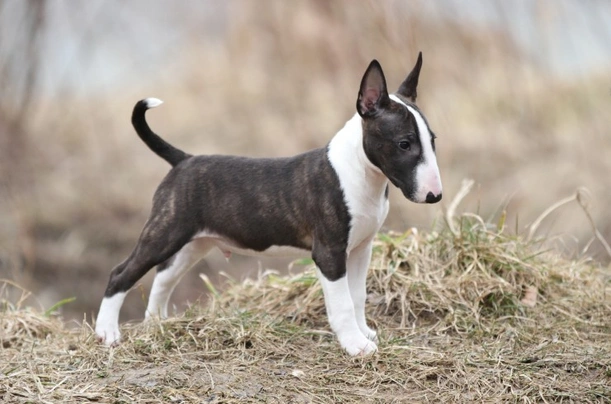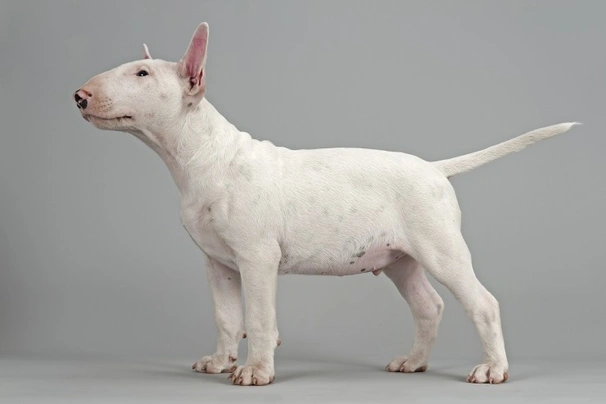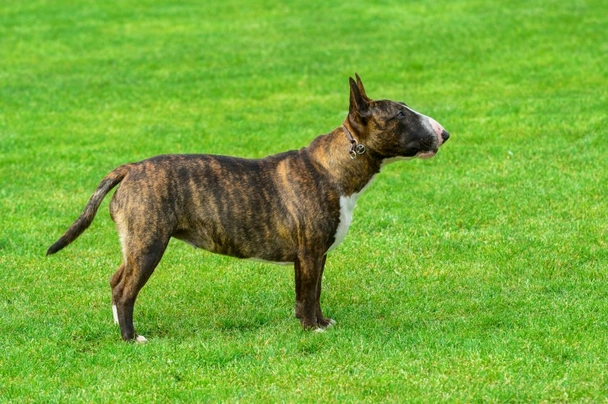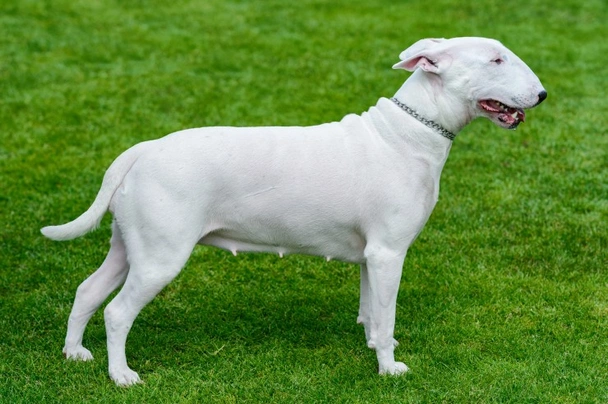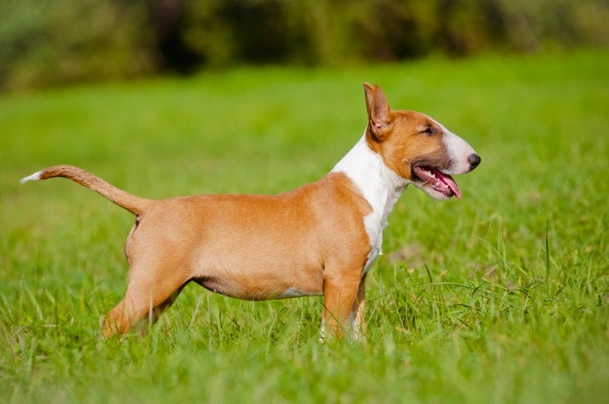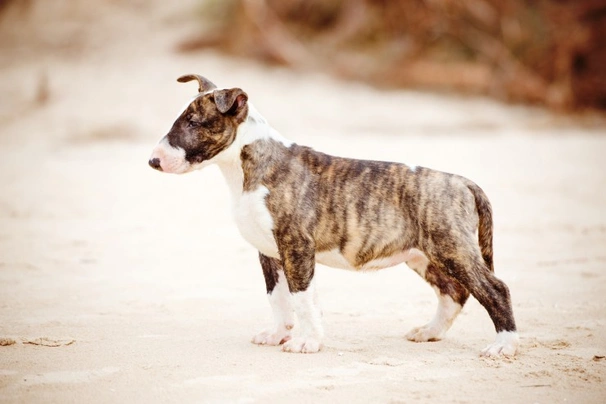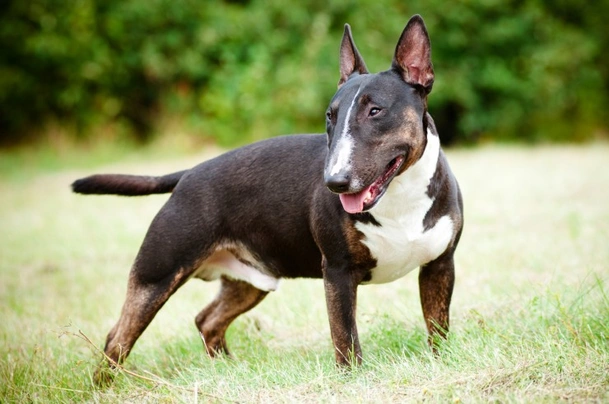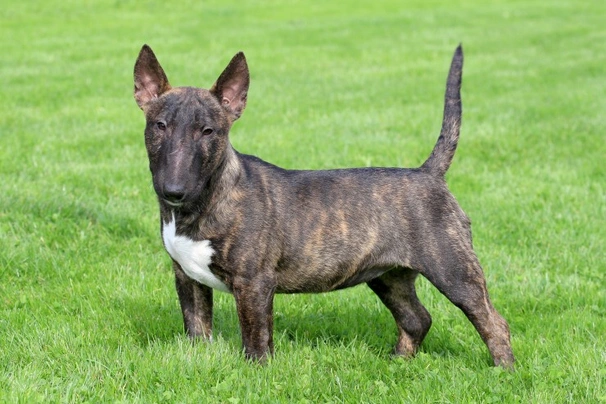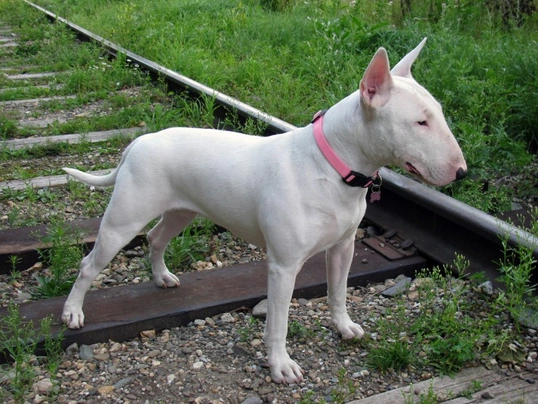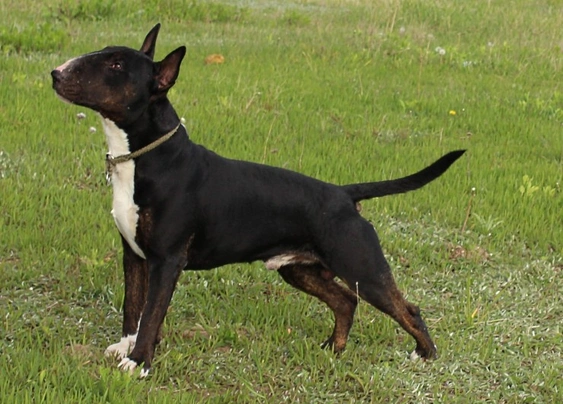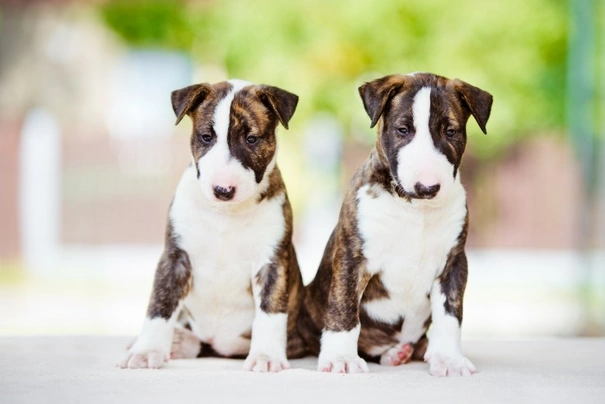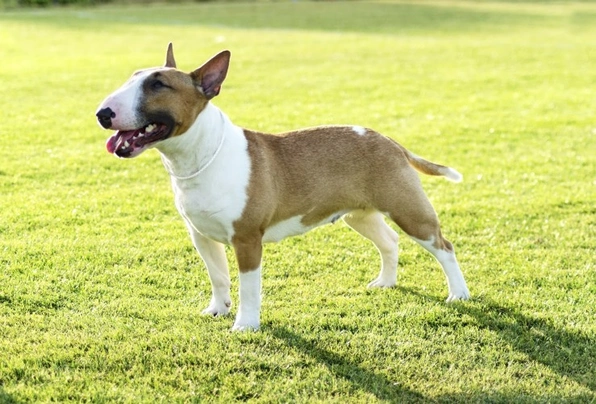English Bull Terrier
Pros
Cons
Introduction of the English Bull Terrier
The Bull Terrier is a very distinctive and powerful looking dog that is a real softie at heart loving nothing more than to be part of a family. Although many of them boast having white coats Bull Terriers come in a lot of other colours which includes brindle. There are no height or weight limits for them but with this said their size should always be in keeping with the breed and whether a dog is female or male. Renowned for their fun-loving and courageous natures Bull Terriers also boast having a bit of a stubborn streak which is why their training must start early and socialising a puppy is an absolute must for them to grow into well-balanced happy mature dogs.
They are not the best choice for first time dog owners because training a Bully can be quite challenging thanks to their stubborn streak. Bull Terrier puppies are incredibly cute and it’s all too easy to spoil them which is a big mistake because Bullies are smart and quickly learn how to dominate a situation if they are allowed and why consistency is essential when handling and training them even when they are puppies.
History of the English Bull Terrier
The Bull Terriers we see today were developed relatively recently and were exhibited at a show in Birmingham in 1962 by James Hinks who is thought to be the breed's original breeder. Interestingly his family are still involved with Bull Terriers even to this day and are highly respected among the breeder’s community.
It was not until 1850 that James Hincks standardised the dogs he bred which he achieved by selectively crossing Bull Terriers with other terrier-type dogs. This included the White English Terrier and his end goal was to create a "Gentleman's Companion". It would be safe to presume that Bulldogs as well as the English White Terrier a dog that sadly no longer exists today are in the English Bull Terrier’s lineage. It is also thought that Hinks may have used Dalmatians as well as other breeds to create the dogs we see today.
Hinks favoured "white" dogs which soon became popular with other people too and in 1887 the Bull Terrier Club was founded. During this period white dogs were generally bred with any coloured Bull Terriers which were thought of as being of a “different” type of dog. However at the beginning of the 20th Century more breeders started to make concerted efforts to breed coloured dogs which led to them being accepted as one type and breed. In 1917 the first of the modern Bull Terrier to be recognised was a dog called "Lord Gladiator".
Today Bull Terriers are among the most popular breeds in the UK both as companion dogs and family pets. Interestingly Miniature Bull Terriers have been around for as long as their larger counterparts but were only recognised as a unique breed by The Kennel Club in 1939.
Interesting facts about the breed
- It the English Bull Terrier a vulnerable breed? No they are one of the most popular new hybrid dogs to have been developed over recent times
- The offspring of white coloured Bull Terriers are always white but some dogs can have markings on their heads
- Offspring of white and coloured parent dogs can either be coloured and/or white in colour
- General Patton had a Bull Terrier as a family pet and became a huge fan of the breed the last dog he owned was called Willie
- It is illegal to dock an English Bull Terrier's tail in the UK which is a law that came into effect in England on the 6th April 2007 in Wales on 28th March 2007 although certain breeds are exempted for working dogs and others may have their tails docked for medical reasons. In Scotland there is a total ban which came into effect on 30th April 2007
Appearance of the English Bull Terrier
Height at the withers: Males 50 - 61 cm Females 50 - 61 cm
Average weight: Males 20 - 29 kg Females 20 - 29 kg
The Bull Terrier is a well-muscled dog that boasts a very distinctively shaped head that is rather long and which boasts being egg-shaped when viewed from the front. The tops of their heads between their ears is virtually flat and in profile their muzzles curve downwards from the top of a dog's head to the tip of their nose. A Bull Terrier's nostrils are well developed and their lower jaw boasts being strong and deep.
Their eyes are quite narrow and triangular shaped being placed obliquely on a dog's face. Colour-wise eyes can be either very black or a dark brown with Bull Terrier's having a very distinct "glint" about them. Ears are small thin and placed neatly close together on a dog’s head and which they carry very upright. The Bull Terrier has a strong jaw with a perfect scissor bite where their upper teeth neatly overlap their lower ones.
Their neck is extremely powerful muscular and long which dogs carry arched and which taper from their shoulders to their heads showing no loose skin whatsoever. Shoulders are muscular strong without being overloaded and a dog's shoulder blades are flat wide and close to the chest wall having a pronounced backward slope to them. Front legs are round with lots of bone which sees the Bull Terrier standing very solidly and squarely on them.
Their body is well rounded with dogs having well sprung ribs a good depth from their withers to their brisket. Their back is quite short but very powerful and level only arching over a dog's well-muscled and broad loins. Bellies curve gently upwards which adds to a dog's powerful appearance.
Hindquarters are powerful with dogs boasting strong well-muscled thighs and second thighs. Feet are compact and round with dog having well arched toes. Their tail is short and set low which dogs carry horizontally. It is thicker at the base but tapers to the tip.
When it comes to their coat the Bull Terrier boasts having a flat short and harsh yet glossy coat with a softer undercoat that typically grows during the colder winter months but vanished in the warmer weather. They have tight fitting skin and the accepted registration Kennel Club breed colours are as follows:
- Black Brindle
- Black Brindle & White
- Brindle
- Brindle & White
- Fawn
- Fawn & White
- Red
- Red & White
- Tricolour
- White
- White with Black Head Markings
- White with Black Markings
- White with Brindle Head Mark
- White with Brindle Markings
- White with Fawn Head Markings
- White with Fawn Markings
- White with Red Head Markings
- White with Red Markings
- White with Tricolour Head Mark
- White with Tricolour Markings
Gait/movement
When Bull Terriers move they do so with determination and purpose moving freely and covering a lot of ground with each stride. They move with a typical "jaunty" gait and when they trot both their front and back legs move in a parallel motion with a nice easy and smooth action at the hip while a nice flex in their stifles and hocks.
Faults
The Kennel Club frowns on any exaggerations or departures from the Bull Terrier breed standard and would judge any faults on how badly they affect a dog's overall health and wellbeing as well as their ability to perform.
Males should have both testicles fully descended into their scrotums and it's worth noting that a Bull Terrier can be a little taller or shorter as well as slightly lighter or heavier than stated in the Kennel Club breed standard which is given as a guideline only.
Temperament of the English Bull Terrier
Over the years and through careful selective breeding responsible Bull Terrier breeders have successfully developed a dog that makes for a wonderful family pet and companion. English Bull Terriers might look ferocious thanks to them being so powerfully built but in fact these dogs boast wonderfully kind and friendly natures with the added bonus of them having a really keen sense of humour.
They are also intelligent characters and need to be given the right amount of mental stimulation and daily exercise to be truly happy well-rounded dogs. With this said Bull Terriers are also known to be headstrong and being such a powerful dog with a lot of "terrier" in them they need to be handled and trained correctly right from the word go.
They are not the best choice for first-time owners because they need to be well trained from a young age so they understand their place in "the pack" and who to look up to for direction and guidance. If they are not handled firmly yet fairly from a young age the English Bull Terrier would soon start to show a more dominant side to their characters which is something to be avoided at all costs.
With this said they are known to be placid and calm by nature although they can have a bit of a stubborn streak in them which is especially true of a dog when they have not received the right amount or sort of training needed from a young enough age. If an English Bull Terrier feels they are being threatened in any way they will react but would rarely be the first dog to show any sort of aggressive behaviour toward another dog. With this said male Bull Terriers might just instigate a fight which is something that owners need to bear in mind when out walking their dog in a public place but it really does depend on the dog and how well they have been socialised as to how they behave towards other dogs.
They are known to be real "people dogs" and as such English Bull Terriers do not like to be left to their own devices for extended periods of time which is why they are not the best choice of dogs for people who spend a lot of time out of the house. They are however a great choice for people who are familiar with this type of dog and where one person usually stays at home when everyone else is out.
They are not the best choice for families with young children simply because they might knock a smaller child over by accident but for people with older children the English Bull Terrier would fit in well to the household becoming a valued and fun member of the family to have around.
Are they a good choice for first time owners?
Bull Terriers are not the best choice for first-time dog owners because they can often get the better of anyone who is not familiar with their specific needs when it comes for caring for them and keeping them entertained. They are much better suited to people who know the breeds little quirks and people who have time to dedicate the time to training an English Bull Terrier when dogs are young and before they get too strong physically.
What about prey drive?
Bull Terriers boast having a competitive spirit which is a trait that is deeply embedded in their psyche. As such they are not that tolerant around smaller animals and will give chase when the opportunity arises. With this said if an English Bull Terrier grows up with smaller animals in the home they generally get on well together which includes the family cat.
What about playfulness?
English Bull Terriers are known to have a real sense of humour and they adore playing interactive games. However care should always be taken when playing with a puppy to make sure they are not showing a more dominant side to their nature rather than just playing a fun game.
What about adaptability?
Bull Terriers are highly adaptable but it would be fair to say they are better suited to people who have safe secure back gardens where dogs can really express themselves as they should whenever possible. As such they are not that well suited to apartment living. Being so intelligent Bull Terriers need to be kept occupied to avoid boredom setting in which could lead to a dog being destructive around the home.
What about separation anxiety?
English Bull Terriers form exceptionally strong bonds with their families and more especially with one person in the household which is usually the person who spends the most time with them and who feeds them. As such they are better suited to families where one person stays at home when other family members are out so they generally always have company.
What about excessive barking?
Bull Terriers are not known to be "barkers" although a dog would be quick off the mark to let an owner know when strangers are about or when something strange is happening in their surroundings. With this said an unhappy English Bull Terrier might bark incessantly as a way of getting attention and showing how unhappy they are at the situation.
Do English Bull Terriers like water?
A lot of Bull Terriers like water and love swimming when the weather is hot. However some dogs sink like stones so it's important to keep a close eye on them whenever they decide to go into the water. With this said it's also essential to keep an English Bull Dog on a lead if they love swimming and they are being walked near any dangerous watercourses.
Are English Bull Terriers good watchdogs?
English Bull Terriers are impressive looking dogs and would deter the bravest of person attempting to enter their environment if they are strangers. As such on looks alone the breed makes for a good watchdog but they should never be trained to guard because it is a natural trait and not one that needs to be enhanced which could end up making a dog too aggressive and dominant.
Intelligence / Trainability of the English Bull Terrier
The English Bull Terrier is an intelligent character and they are capable of learning things relatively quickly. However as previously mentioned they do have a bit of a stubborn streak in them which is why they are not the best choice for people who are not familiar with the breed or this type of dog. They do not respond well to any sort of harsh correction or heavy-handed training but they do answer well to positive reinforcement and consistent training from someone they know they can look up to for direction.
Bull Terrier puppies must be taught the ground rules right from the word go so they understand the limits and boundaries an owner sets for them bearing in mind that a puppy will always tests these when they mood takes them. Consistency is essential because these cute little puppies grow up to be powerful strong willed dogs that need to know what is expected of them and most importantly their place in the pack and who is the alpha dog in a household. The first commands an English Bull Terrier should be taught are as follows:
- Good
- Bad
- No
- Leave
- Drop it
- Come
- Stay
- Heel
- Sit
- Down
- Bed
Children and other
English Bull Terriers are known to have an affinity with young children but thanks to their playful boisterous natures any interaction between a dog and the kids should always be well supervised to make sure nobody gets too excited.
Male English Bull Terriers tend to be a little more aggressive towards other dogs than their female counterparts which is why it is so important for them to be well-socialised from a young age which should involve introducing them to as many new situations people and dogs as possible once they have been full vaccinated so they mature to be more relaxed when they are around other dogs and animals they may encounter.
Care needs to be taken when English Bull Terriers are around cats small animals and pets because they might just view them as "fair game" thanks to their high prey drive bearing in mind that they have a lot of "terrier" in them. With this said if an English Bull Terrier grows up with smaller animals in the home which includes a family cat they usually get on well with them.
Health of the English Bull Terrier
The average life expectancy of an English Bull Terrier is between 10 and 14 years when properly cared for and fed an appropriate good quality diet to suit their ages.
Thanks to good breeding practices by reputable Bull Terrier breeders the breed is generally strong and healthy but like other breeds with white coats the English Bull Terrier is prone to deafness. The good news is that more breeders than ever are now screening their dogs before using them in a breeding programme which means the number of Bull Terriers with hearing issues is dropping. Other conditions that seem to affect the breed the most include the following:
- Deafness - test available
- Heart disease - test available
- Kidney disease - test available although not conclusive
- Patellar luxation
- Umbilical Hernia
- Acne - skin and coat conditions
More about deafness
Deafness has been a real concern in the breed right from the outset when they were first developed and research has established that up to 18% of white dogs may have impaired hearing. For a long time it was thought to be a disorder that only affected "white" dogs but studies have shown that some coloured Bull Terrier can be affected too. The bad news is that even when deaf dogs are not used in a breeding programme puppies can still be born deaf and it is thought that this is because it is so difficult to establish if parent dogs are partially deaf which is an easy mistake to make.
A Bull Terrier that is born deaf in one ear is known as being "unilaterally deaf" and dogs are very able to adapt and lead normal lives. All too often a dog that is deaf in one ear will run in the wrong direction when called or they scan their environment before reacting which can help determine if they have a hearing problem although it is not that reliable. Unilaterally deaf Bull Terriers should not be used for breeding purposes.
Bull Terriers that are born completely deaf have a much harder time coping and adapting. They are very much harder to train as a result too. All too often when they are woken up too suddenly they react defensively because they are startled. With this said there are stories of totally deaf English Bull Terriers making wonderful companions and that they go on to lead full and happy lives although this is quite exceptional.
The good news is that all reputable Bull Terrier breeds now have stud dogs BAER tested to ensure their hearing is good. The tests can be carried out on puppies when they are around 5 weeks old and again reputable breeders would always have the puppies tested before selling them. It is worth noting that not many veterinary surgeries have the equipment to carry out this type of test but there are many animal centres all over the UK where tests can be carried out one of which is the Animal Health Trust and there's even a mobile testing unit that covers some parts of the country too.
More about heart disease
Studies have shown that Bull Terriers are predisposed to suffering from certain types of heart disease which negatively impacts their heart valves. The result of valves not functioning as they should is that dogs suffer heart attacks with milder symptoms including a shortness of breath and an unwillingness to exercise.
Dogs can be tested and would be graded on the severity of their condition with some dogs having a heart murmur throughout their lives without the disorder getting any worse or them showing any other symptoms of there being an issue with their hearts. Reputable breeders would never use a dog known to have a heart issue in a breeding programme as it is the only way of reducing the risk of their offspring being born with the condition. All breeding dogs should be tested when they are 12 months old before being used for breeding purposes.
More about kidney disease
For many years kidney disease has been a real health issue for English Bull Terriers. The condition may flare up at any time in a dog's life with some affected dogs dying very young. Sadly once a Bull Terrier is diagnosed as suffering kidney failure there is very little that can be done for them. However if a problem is diagnosed early enough the prognosis is slightly better more especially if a dog is put on a special diet which has been seen to help when it comes to a dog's quality of life.
Over recent years another condition has been identified in the breed which is known as "Polycistic Kidneys" and the condition can be diagnosed using an ultrasound. The bad news is that the prognosis is never good and most dogs succumb to their symptoms early on.
How kidney disease is inherited remains unknown but there is a screening test which although not conclusive is available and which all responsible breeders use on their stud dogs before breeding from them. Most vets can carry out the test in their surgeries because it involves taking a simple urine sample which can then be sent for analysis before issuing a health certificate to a dog.
More about Patellar Luxation
It is thought that patellar luxation could be an inherited disorder and therefore any Bull Terrier suffering from the condition should not be used for breeding purposes as this is the only way of reducing the risk of offspring being passed the condition from their parents. However it is worth noting that the condition can also be acquired through injury or trauma.
More about skin and coat conditions
English Bull Terriers are prone to allergies skin and coat issues which sadly are very commonly seen in the breed. The triggers can be seasonal or other and the problem can be slight or very severe which includes dogs developing mange leaving a Bull Terrier's skin looking more like that of a Rhino. Skin issues although not life threatening are very painful and uncomfortable for dogs to have to live with and the sooner a Bull Terrier is seen by a vet the faster they can be made to feel more at ease although finding the root cause of the problem can often take a long time.
More about tail docking in the UK
It is illegal to dock an English Bull Terrier's tail in the UK which is a law that came into effect in England on the 6th April 2007 in Wales on 28th March 2007 although certain breeds are exempted for working dogs and others may have their tails docked for medical reasons. In Scotland there is a total ban which came into effect on 30th April 2007
What about vaccinations?
English Bull Terrier puppies would have been given their first vaccinations before they are sold but it is then up to their owners to ensure they are given their follow-up shots in a timely fashion. The vaccination schedule for puppies is as follows:
- 10 -12 weeks old bearing in mind that a puppy would not have full protection straight away but would be fully protected 2 weeks after they have had their second vaccination
There has been a lot of discussion about the need for dogs to have boosters. As such it's best to talk to a vet before making a final decision on whether a dog should continue to have annual vaccinations which are known as boosters.
What about spaying and neutering?
A lot of vets prefer to wait until an English Bull Terrier is around 9 months old before spaying or neutering them because dogs are that much more mature before undergoing the procedures. With this said other vets recommend spaying and neutering dogs when they are 6 months old but never earlier unless for medical reasons.
What about obesity problems?
Older Bull Terriers are more prone to putting on weight which is why a close eye should be kept on their calorie intake and the amount of daily physical exercise a dog is given. Some dogs when they are spayed or neutered may also put on weight after the procedures and again it's important to keep an eye on a dog's waistline and to adjust their diet and daily exercise accordingly. Obesity can negatively impact a dog's overall health and wellbeing shortening their lives by several years thanks to the extra pressure that's put on their hearts and other vital internal organs.
What about allergies?
As previously mentioned English Bull Terriers are predisposed to skin and coat issues and finding the triggers can prove challenging. The most common triggers are as follows:
- Environment
- A reaction to certain chemicals commonly found in household cleaning products
- Seasonal allergies which includes pollen and grasses
- Food which includes certain meats and cereals often used as ingredients in commercially produced dog food
- Tick and flea bites
- Dust mites
- Mould
Participating in health schemes
The good news is that all reputable Bull Terrier breeds now have stud dogs BAER tested to ensure their hearing is good. The tests can be carried out on puppies when they are 5 weeks old. The Kennel Club strongly advises that all breeders use the following schemes:
What about breed specific breeding restrictions?
As well as the standard breeding restrictions for Kennel Club registered breeds English Bull Terriers can be mated to Miniature Bull Terriers but prior approval must be sought from the Kennel Club.
As of the 1st March 2011 any merle Bull Terriers puppies born on or afterwards cannot be registered with the Kennel Club because of the health risks associated with the merle gene namely impaired sight and hearing.
As of 1st January 2013 the Kennel Club no longer accepts registration of puppies born from two merle parent dogs on this date or afterwards because of the health risks associated with the merle gene namely impaired sight and hearing.
What about Assured Breeder Requirements?
The Kennel Club strongly advises that all breeders whether Assured Breeders or other use the schemes below any dogs they intend to breed from:
Caring for the English Bull Terrier
As with any other breed Bull Terriers need to be groomed on a regular basis to make sure their coats and skin are kept in top condition bearing in mind that English Bull Terriers are prone to suffering from allergies. They also need to be given regular daily exercise to ensure they remain fit and healthy. On top of this dogs need to be fed good quality food that meets all their nutritional needs throughout their lives.
Caring for an English Bull Terrier puppy
English Bull Terrier puppies are adorable and it can be all too easy to spoil them because of this. However anyone who shares a home with a puppy knows that it's essential to set out the ground rules right from the word go and more especially with breeds that grow into strong and powerful mature dogs. Puppies need to know the limits and boundaries which many will test from time to time sometimes out of naughtiness and others because they show a more dominant side to their natures and it's important to know the difference.
It's best to introduce a puppy to their new homes when people are going to be around for the first week to ten days because it would be a mistake to leave them on their own during the settling in period. Even the most outgoing and confident puppy needs to have someone around because they will be feeling vulnerable having just left mum and littermates.
Bull Terrier puppies are generally good to housetrain providing they are given the right sort of direction which means putting down puppy training pads in strategic places and always keeping an eye on when a dog wants to go to the toilet. It's always a good idea not to let a puppy have the run of the house not only to keep them safe but to prevent them from having "accidents" all over the place. When a puppy gets it right it's important to calmly praise them with lots of rewards.
Sleep is very important for all puppies because they need to nap a lot for them to grow and develop correctly. A puppy can sleep for up to 21 hours a day so it's essential they have a quiet corner to retreat to when they want to sleep. The area should not be too out of the way though because a puppy needs to know someone is around but it should be away from lots of traffic. If there are children in the house they should be taught not to disturb a puppy when they are napping or when they are eating either.
It's also a good idea to get a Bull Terrier puppy used to wearing a light weight collar quite early in their lives and to leave it on for an hour or so every day. At the same time it's a good idea to get them used to a lead too making it as much fun as possible so the experience is a positive one. It's essential for any minor bad behaviours to be gently checked when a puppy is still young and before they get too powerful and strong.
Wilful and difficult puppies
Some Bull Terrier puppies can be a little wilful which can be put down to several things with the first being that the puppy is more dominant by nature. It could be they were not well enough socialised when they were with their mothers or littermates too. The key to successfully handling a strong-willed puppy is to be patient confident and to always be the alpha dog so any fear aggression dominance and possessiveness is gently held in check.
What about puppies that bite?
When Bull Terrier puppies are 6-months old their education must include some discipline and the best place to do this is either in the house or the garden where there won't be any distractions. It's essential these powerful dogs be taught to walk to heel and to be totally focused on what owners are asking of them. It's always a good idea to enroll a Bull Terrier puppy into training classes once they are fully vaccinated because it ensures they get to meet more people and other dogs while at the same time being trained in a safe and secure environment.
When a puppy bites which includes hands and clothes it is their way of showing a more dominant side to their natures and this type of behaviour must be gently nipped in the bud to prevent it from turning into a real problem. Puppies should also be gently scolded for guarding things which includes food toys and anything else around the home. It is also essential that English Bull Terrier puppies are not deliberately taught to "guard" anything because it could see them turning into a more possessive and aggressive dog.
The documentation a breeder provides for a puppy must have all the details of their worming date and the product used as well as the information relating to their microchip. It is essential for puppies to be wormed again keeping to a schedule which is as follows:
- Puppies should be wormed at 6 months old
- They need to be wormed again when they are 8 months old
- Puppies should be wormed when they are 10 months old
- They need to be wormed when they are 12 months old
Things you'll need for your puppy
There are certain items that new owners need to already have in the home prior to bringing a new puppy home. It's often a good idea to restrict how much space a puppy plays in more especially when you can't keep an eye on what they get up to bearing in mind that puppies are often quite boisterous which means investing in puppy gates or a large enough playpen that allows an English Bull Terrier puppy the room to express themselves while keeping them safe too. The items needed are therefore as follows:
- Good quality puppy or baby gates to fit on doors
- A good well-made playpen that's large enough for a English Bull Terrier puppy to play in so they can really express themselves as puppies like to do
- Lots of well-made toys which must include good quality chews suitable for puppies to gnaw on bearing in mind that a puppy will start teething anything from when they are 3 to 8 months old
- Good quality feed and water bowls which ideally should be ceramic rather than plastic or metal
- A grooming glove
- A slicker brush or soft bristle brush
- Dog specific toothpaste and a toothbrush
- Scissors with rounded ends
- Nail clippers
- Puppy shampoo and conditioner which must be specifically formulated for use on dogs
- A well-made dog collar or harness
- A couple of strong dog leads
- A well-made dog bed that's not too small or too big
- A well-made dog crate for use in the car and in the home that's large enough for a English Bull Terrier puppy to move around in
- Baby blankets to put in your English Bull Terrier's crate and in their beds for when they want to nap or go to sleep at night
Keeping the noise down
All puppies are sensitive to noise including English Bull Terrier puppies. It's important to keep the noise levels down when a new puppy arrives in the home. TVs and music should not be played too loud which could end up stressing a small puppy out.
Keeping vet appointments
As previously touched upon Bull Terrier puppies would have been given their first vaccinations before being sold but it's essential they have their follow-up shots in a timely fashion with the schedule being as follows:
- 10 -12 weeks old bearing in mind that a puppy would not have full protection straight away but would only be fully protected 2 weeks after they have had their second vaccination
When it comes to boosters it's best to discuss these with a vet because there is a lot of debate about whether a dog really needs them after a certain time. However if a dog ever needed to go into kennels their vaccinations would need to be
What about older English Bull Terriers when they reach their senior years?
Older English Bull Terriers need lots of special care because as they reach their golden years they are more at risk of developing certain health concerns. Physically an English Bull Terrier will start to have a greying muzzle but there will be other noticeable changes too which includes the following:
- Coats become coarser
- A loss of muscle tone
- English Bull Terriers can either become overweight or underweight
- They have reduced strength and stamina
- Older dogs have difficulty regulating their body temperature
- They often develop arthritis
- Immune systems do not work as efficiently as they once did which means dogs are more susceptible to infections
Older dogs change mentally too which means their response time tends to be slower as such they develop the following:
- They respond less to external stimuli due to impaired vision or hearing
- They tend to be a little pickier about their food
- They have a lower pain threshold
- Become intolerant of any change
- Often an older dog can feel disorientated
Living with a English Bull Terrier in their golden years means taking on a few more responsibilities but these are easily managed and should include taking a look at their diet the amount of exercise they are given how often their dog beds need changing and keeping an eye on the condition of their teeth.
Older English Bull Terriers need to be fed a good quality diet that meets their needs at this stage of their lives all the while keeping a close eye on a dog's weight. A rough feeding guide for older English Bull Terriers is as follows bearing in mind they should be fed highly digestible food that does not contain any additives:
- Protein content should be anything from 14 – 21%
- Fat content should be less than 10%
- Fibre content should be less than 4%
- Calcium content should be 0.5 – 0.8%
- Phosphorous content should be 0.4 – 0.7%
- Sodium content should be 0.2 – 0.4%
Older English Bull Terriers don't need to be given the same amount of daily exercise as a younger dog but they still need the right amount of physical activity to maintain muscle tone and to prevent a dog from putting on too much weight. All dogs need access to fresh clean water and this is especially true of older dogs when they reach their golden years because they are more at risk of developing kidney disorders.
Grooming of the English Bull Terrier
Thanks to their short tight coats the English Bull Terrier is low maintenance on the grooming front. Their coats are no-fuss and need very little in the way of grooming although puppies need to be introduced to all the tools needed to keep their coats and skin looking good so they learn to enjoy a grooming session and the one-to-one attention they are given when they are being brushed. It’s particular important to touch and play with a puppy’s paws their nails ears and other parts of their body so when it comes to trimming nails checking ears and doing other things to them dogs don’t get stressed out bearing in mind that a Bull Terrier that wriggles makes it that much harder to clip nails and check things over.
Older dogs just need to be given the once over with a grooming mitt twice a week to keep their coats shiny and to check their skin for any signs of acne or other conditions the breed is known to suffer from. It's also important to check a dog's ears on a regular basis and to clean them when necessary. If too much wax builds up in a dog's ears it can lead to a painful infection which can be hard to clear up. In short prevention is often easier than cure when it comes to ear infections.
Exercise of the English Bull Terrier
English Bull Terriers are active energetic characters and as such they need to be given the right amount of physical exercise and mental stimulation for them to be truly happy well-rounded characters. The saying a "tired dog is a good dog" is never truer than when describing a Bull Terrier. They need to be given a minimum of two walks a day and be out for anything up to 2 hours. A shorter walk in the morning would be fine but a much longer and more interesting walk in the afternoon is a must for these dogs.
They also benefit from being able to run around a back garden as often as they can but the fencing has to be very secure to keep an English Bull Terrier in because if they find a weak spot a dog would soon be out and off exploring.
With this said young Bull Terrier puppies should not be given too much exercise because their joints and bones are still growing and too much pressure on them could result in causing a dog a few problems later in their lives. They should not be allowed to jump up or off furniture nor should they be allowed to run up and down the stairs because this puts too much pressure on their still growing joints and limbs.
Feeding of the English Bull Terrier
If you get an English Bull Terrier puppy from a breeder they would give you a feeding schedule and it's important to stick to the same routine feeding the same puppy food to avoid any tummy upsets. You can change a puppy's diet but this needs to be done very gradually always making sure they don't develop any digestive upsets and if they do it's best to put them back on their original diet and to discuss things with the vet before attempting to change it again.
Older dogs are not known to be fussy or finicky eaters but this does not mean you can feed them a lower quality diet. It's best to feed a mature dog twice a day once in the morning and then again in the evening making sure it's good quality food that meets all their nutritional requirements. It's also important that dogs be given the right amount of exercise so they burn off any excess calories or they might gain too much weight which can lead to all sorts of health issues. Obesity can shorten a dog's life by several years so it's important to keep an eye on their waistline from the word go.
English Bull Terriers have extremely powerful jaws and as such they are very capable of splintering bones they are given which can cause serious digestive issues and may even perforate a dog's gut. As such it's best to avoid giving them any sort of bone and instead to offer a dog good quality chews that a dog won't consume in minutes. When a chew gets too small it's best to take this away from a Bull Terrier when they are asleep or doing something else and to replace it with a new and larger chew. The reason being that when a chew gets too small a dog might swallow it whole and it could cause a blockage.
It is also worth noting that Bull Terriers should NEVER be offered any sort of rawhide chews because they tend to swallow these whole as soon as they can which again can lead to a serious intestinal blockage.
Feeding guide for an English Bull Terrier puppy
Puppies need to be fed a highly nutritious good quality diet for them to develop and grow as they should. As a rough guide a English Bull Terrier puppy can be fed the following amounts every day making sure their meals are evenly spread out throughout the day and it's best to feed them 3 or 4 times a day:
- 2 months old - 214g to 238g depending on puppy's build
- 3 months old - 256g to 292g depending on puppy's build
- 4 months old - 275g to 318g depending on puppy's build
- 5 months old - 281g to 361g depending on puppy's build
- 6 months old - 281g to 361g depending on puppy's build
- 8 months old - 244g to 325g depending on puppy's build
- 10 months old - 202g to 261g depending on puppy's build
Once a puppy is 13 months old they can be fed adult dog food.
Feeding guide for an adult English Bull Terrier
Once fully mature an adult English Bull Terrier must be fed a good quality diet to ensure their continued good health. As a rough guide an adult English Bull Terrier can be fed the following amounts every day:
- Dogs weighing 20 kg can be fed 233g to 307g depending on activity
- Dogs weighing 25 kg can be fed 275g to 362g depending on activity
- Dogs weighing 29 kg can be fed 315g to 392g depending on activity
English Bull Terrier price
If you are looking to buy an English Bull Terrier you would need to pay anything from £400 to over £1000 for a well-bred pedigree puppy. The cost of insuring a male 3-year-old English Bull Terrier in northern England would be £58.05 a month for basic cover but for a lifetime policy this would set you back £115.89 a month (quote as of September 2017). When insurance companies calculate a pet's premium they factor in several things which includes where you live in the UK and a dog's age and whether they have been neutered or spayed.
When it comes to food costs you need to buy the best quality food whether wet or dry to feed your dog throughout their lives making sure it suits the different stages of their lives. This would set you back between £40 - £50 a month. On top of this you would need to factor in veterinary costs if you want to share your home with an English Bull Terrier and this includes their initial vaccinations their annual boosters the cost of neutering or spaying your dog when the time is right and their yearly health checks all of which quickly adds up to over a £1000 a year.
As a rough guide the average cost to keep and care for an English Bull Terrier would be between £90 to £160 a month depending on the level of insurance cover you opt to buy for your dog but this does not include the initial cost of buying a well-bred healthy pedigree puppy.
Buying advice
When visiting and buying any puppy or dog there are many important things to consider and questions to ask of the breeder/seller. You can read our generic puppy/dog advice here which includes making sure you see the puppy with its mother and to verify that the dog has been wormed and microchipped.
English Bull Terriers are an extremely popular breed both in the UK and elsewhere in the world which means that well-bred puppies command a lot of money. As such with English Bull Terriers there is specific advice questions and protocols to follow when buying a puppy which are as follows:
- Beware of online scams and how to avoid them. You may see online and other adverts by scammers showing images of beautiful Bull Terrier puppies for sale at very low prices. However the sellers ask buyers for money up front before agreeing to deliver a puppy to a new home. Potential buyers should never buy a puppy unseen and should never pay a deposit or any other money online to a seller. You should always visit the pet at the sellers home to confirm they are genuine and make a note of their address.
- As previously touched upon English Bull Terriers are among the most popular breeds in the UK. As such there are many amateur breeders/people who breed from English Bull Terriers far too often so they can make a quick profit without caring for the welfare of the puppies their dam or the breed in general. Under Kennel Club rules a dam can only produce 4 litters and she must be between a certain age to do so. Anyone wishing to buy a English Bull Terrier puppy should think very carefully about who they purchase their puppy from and should always ask to see the relevant paperwork pertaining to a puppy's lineage their vaccinations and their microchipping
- Prospective buyers should be aware that English Bull Terriers can be mated to Miniature Bull Terriers but only if prior approval is sought from the Kennel Club.
- As of the 1st March 2011 any merle Bull Terriers puppies born on or afterwards cannot be registered with the Kennel Club because of the health risks associated with the merle gene namely impaired sight and hearing.
- As of 1st January 2013 the Kennel Club no longer accepts registration of puppies born from two merle parent dogs on this date or afterwards because of the health risks associated with the merle gene namely impaired sight and hearing.
- It is illegal to dock an English Bull Terrier's tail in the UK which is a law that came into effect in England on the 6th April 2007 in Wales on 28th March 2007 although certain breeds are exempted for working dogs and others may have their tails docked for medical reasons. In Scotland there is a total ban which came into effect on 30th April 2007

🏴🏆🏆🏆🏆🏆 English bull terrier pups
£2,200
Beautiful English bull terrier puppy’s all boys
£2,000
